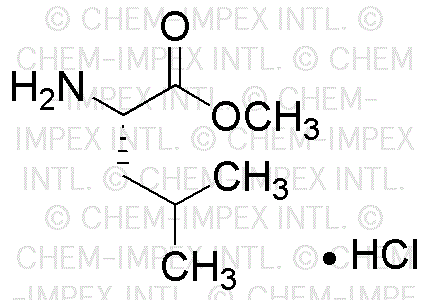L-Leucine methyl ester hydrochloride is widely utilized in research focused on:
- Protein Synthesis: This compound serves as a building block for proteins, making it essential in studies related to muscle growth and recovery in sports science.
- Pharmaceutical Development: It is used in the formulation of various drugs, particularly those targeting metabolic disorders, due to its role in amino acid metabolism.
- Biotechnology: Researchers employ this chemical in the production of peptides and other bioactive compounds, enhancing the efficiency of bioprocessing techniques.
- Food Industry: It acts as a flavor enhancer and nutritional supplement, particularly in protein-rich products aimed at athletes and health-conscious consumers.
- Cosmetics: The compound is incorporated into skincare formulations for its potential benefits in promoting skin health and hydration.
General Information
Properties
Safety and Regulations
Applications
L-Leucine methyl ester hydrochloride is widely utilized in research focused on:
- Protein Synthesis: This compound serves as a building block for proteins, making it essential in studies related to muscle growth and recovery in sports science.
- Pharmaceutical Development: It is used in the formulation of various drugs, particularly those targeting metabolic disorders, due to its role in amino acid metabolism.
- Biotechnology: Researchers employ this chemical in the production of peptides and other bioactive compounds, enhancing the efficiency of bioprocessing techniques.
- Food Industry: It acts as a flavor enhancer and nutritional supplement, particularly in protein-rich products aimed at athletes and health-conscious consumers.
- Cosmetics: The compound is incorporated into skincare formulations for its potential benefits in promoting skin health and hydration.
Documents
Safety Data Sheets (SDS)
The SDS provides comprehensive safety information on handling, storage, and disposal of the product.
Product Specification (PS)
The PS provides a comprehensive breakdown of the product’s properties, including chemical composition, physical state, purity, and storage requirements. It also details acceptable quality ranges and the product's intended applications.
Certificates of Analysis (COA)
Search for Certificates of Analysis (COA) by entering the products Lot Number. Lot and Batch Numbers can be found on a product’s label following the words ‘Lot’ or ‘Batch’.
*Catalog Number
*Lot Number
Certificates Of Origin (COO)
This COO confirms the country where the product was manufactured, and also details the materials and components used in it and whether it is derived from natural, synthetic, or other specific sources. This certificate may be required for customs, trade, and regulatory compliance.
*Catalog Number
*Lot Number
Safety Data Sheets (SDS)
The SDS provides comprehensive safety information on handling, storage, and disposal of the product.
DownloadProduct Specification (PS)
The PS provides a comprehensive breakdown of the product’s properties, including chemical composition, physical state, purity, and storage requirements. It also details acceptable quality ranges and the product's intended applications.
DownloadCertificates of Analysis (COA)
Search for Certificates of Analysis (COA) by entering the products Lot Number. Lot and Batch Numbers can be found on a product’s label following the words ‘Lot’ or ‘Batch’.
*Catalog Number
*Lot Number
Certificates Of Origin (COO)
This COO confirms the country where the product was manufactured, and also details the materials and components used in it and whether it is derived from natural, synthetic, or other specific sources. This certificate may be required for customs, trade, and regulatory compliance.


